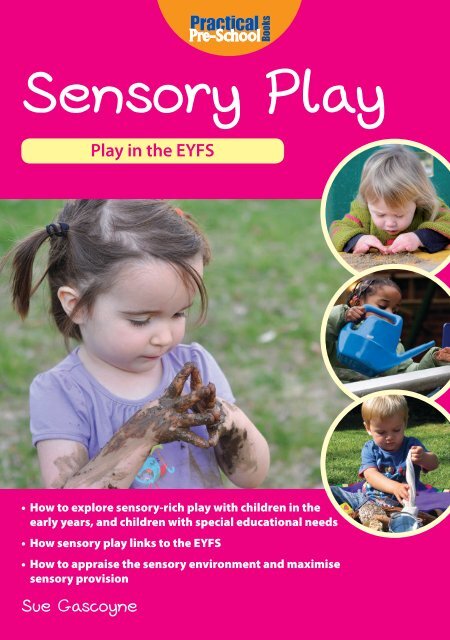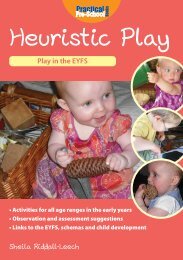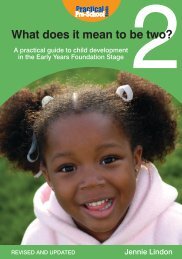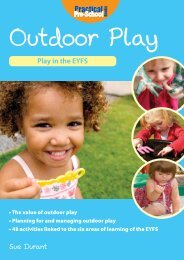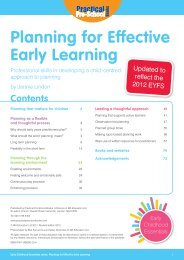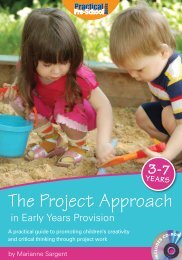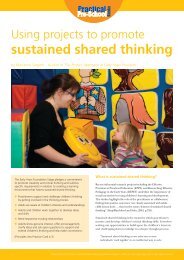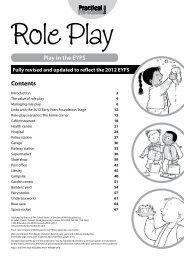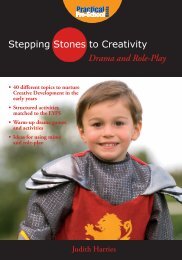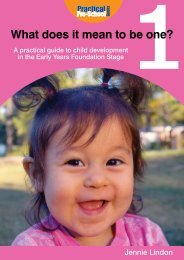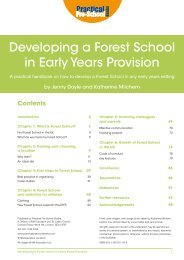Play in the EYFS Contents - Practical Pre-School Books
Play in the EYFS Contents - Practical Pre-School Books
Play in the EYFS Contents - Practical Pre-School Books
You also want an ePaper? Increase the reach of your titles
YUMPU automatically turns print PDFs into web optimized ePapers that Google loves.
<strong>Books</strong><br />
Sensory <strong>Play</strong><br />
<strong>Play</strong> <strong>in</strong> <strong>the</strong> <strong>EYFS</strong><br />
• How to explore sensory-rich play with children <strong>in</strong> <strong>the</strong><br />
early years, and children with special educational needs<br />
• How sensory play l<strong>in</strong>ks to <strong>the</strong> <strong>EYFS</strong><br />
• How to appraise <strong>the</strong> sensory environment and maximise<br />
sensory provision<br />
Sue Gascoyne
<strong>Books</strong><br />
Sensory <strong>Play</strong><br />
<strong>Play</strong> <strong>in</strong> <strong>the</strong> <strong>EYFS</strong><br />
<strong>Contents</strong><br />
Introduc<strong>in</strong>g sensory play 2<br />
Our amaz<strong>in</strong>g senses 11<br />
Sensory play <strong>in</strong> action 17<br />
Sensory play and special educational needs 46<br />
Curriculum l<strong>in</strong>ks 52<br />
The adult’s role 58<br />
Conclusion 62<br />
Fur<strong>the</strong>r references 63<br />
For Freya and Zach, for teach<strong>in</strong>g me all <strong>the</strong>y know about sensory play.<br />
Published by <strong>Practical</strong> <strong>Pre</strong>-<strong>School</strong> <strong>Books</strong> , A Division of MA Education Ltd,<br />
St Jude’s Church, Dulwich Road, Herne Hill, London, SE24 0PB<br />
Tel 020 7738 5454 www.practicalpreschoolbooks.com<br />
© MA Education Ltd 2011<br />
Front cover photos clockwise from left: © iStockphoto.com/Don Barens, © iStockphoto.com/Jeffrey Stroh,<br />
© MA Education Ltd 2011/Ben Suri, © Sue Gascoyne 2011<br />
Illustrated by Cathy Hughes<br />
All rights reserved. No part of this publication may be reproduced, stored <strong>in</strong> a retrieval system, or transmitted<br />
by any means, electronic, mechanical, photocopied or o<strong>the</strong>rwise, without <strong>the</strong> prior permission of <strong>the</strong> publisher.<br />
<strong>Play</strong> <strong>in</strong> <strong>the</strong> <strong>EYFS</strong>: Sensory <strong>Play</strong> ISBN: 978-1-907241-23-9
Introduc<strong>in</strong>g sensory play<br />
What is sensory play?<br />
Imag<strong>in</strong>e a walk <strong>in</strong> <strong>the</strong> woods; a visit to <strong>the</strong> seaside; a child<br />
mix<strong>in</strong>g and splodg<strong>in</strong>g pa<strong>in</strong>t with a fat brush, or better still<br />
<strong>the</strong>ir f<strong>in</strong>gers; or build<strong>in</strong>g with smooth wooden blocks. What<br />
do <strong>the</strong>se all have <strong>in</strong> common? Each experience is <strong>in</strong>extricably<br />
l<strong>in</strong>ked to <strong>the</strong> senses. For example, <strong>the</strong> woodland walk<br />
conjures up crunch<strong>in</strong>g leaves underfoot while dappled light<br />
casts on tree trunks ripe for climb<strong>in</strong>g. A trip to <strong>the</strong> seaside<br />
offers <strong>the</strong> satisfaction of shap<strong>in</strong>g wet sand, creat<strong>in</strong>g channels<br />
for froth<strong>in</strong>g water and <strong>the</strong> taste of salty air. Pa<strong>in</strong>t<strong>in</strong>g gives <strong>the</strong><br />
pleasure and cold silky feel of pa<strong>in</strong>t or <strong>the</strong> visual explosion<br />
of colour as shades mix and loop. Block play offers <strong>the</strong><br />
opportunity to create imag<strong>in</strong>ary castles with cool wooden<br />
blocks satisfy<strong>in</strong>gly cl<strong>in</strong>k<strong>in</strong>g. The essence of <strong>the</strong> experience is<br />
both captured and conveyed through <strong>the</strong> colour and lights,<br />
sounds, feel, warmth, smells and taste.<br />
Activity<br />
mak<strong>in</strong>g mud pies, and rose petal perfume and <strong>the</strong> appeal<br />
of multi-sensory play is evident.<br />
Activity<br />
For a rem<strong>in</strong>der of <strong>the</strong> sensory limitations of plastic,<br />
close your eyes and place your hand <strong>in</strong> a bag of brightly<br />
coloured plastic toys. As <strong>the</strong> visual stimulus is removed, <strong>the</strong><br />
appeal and ‘differentness’ of <strong>the</strong>se toys quickly disappears.<br />
For someth<strong>in</strong>g so fundamental to children’s growth<br />
and development, def<strong>in</strong>itions of sensory play itself are<br />
remarkably elusive! Sensory play is essentially play that<br />
engages one or more of <strong>the</strong> senses. As such most play clearly<br />
has <strong>the</strong> potential to be sensory. Sensory play differs to o<strong>the</strong>r<br />
types of play <strong>in</strong> that <strong>the</strong> sensory focus adds a significant and<br />
<strong>in</strong>tegral extra dimension to <strong>the</strong> play. Usher (2010) def<strong>in</strong>es<br />
Try to imag<strong>in</strong>e a vivid childhood play memory where one<br />
or more of your senses was really prom<strong>in</strong>ent. What do<br />
you th<strong>in</strong>k makes it so vivid? How does it make you feel?<br />
Compare <strong>the</strong>se experiences to <strong>the</strong> visual focus and passive<br />
nature of watch<strong>in</strong>g television or play<strong>in</strong>g computer games –<br />
just two of <strong>the</strong> trends <strong>in</strong> 21st century play cited <strong>in</strong> a recent<br />
research project (Sue Gascoyne, January 2010). Or visit <strong>the</strong><br />
average toy shop, with shelf upon shelf of brightly coloured<br />
toys, some of which flash, bleep or talk, and <strong>the</strong> visual (and<br />
to a lesser extent auditory) focus of many toys is apparent.<br />
Opportunities for children to actually touch or taste are<br />
often discouraged, or limited to plastic. <strong>Play</strong> now primarily<br />
takes place <strong>in</strong>doors, where temperatures are constant,<br />
and smells and environmental sounds masked.<br />
All this contributes to play where sensory<br />
experience is limited. Contrast this with <strong>the</strong><br />
vivid childhood play memories you may<br />
have of runn<strong>in</strong>g barefoot through grass,<br />
2 Sensory <strong>Play</strong>
Introduc<strong>in</strong>g sensory play<br />
sensory play as “play that provides opportunities for children<br />
... to use all <strong>the</strong>ir senses, or play that encourages <strong>the</strong> use of<br />
one particular sense”. Sensory play is commonly accessed<br />
<strong>in</strong> <strong>the</strong> outdoor environment, and some forms, like sand<br />
and water play, can be <strong>in</strong>tr<strong>in</strong>sically messy – although this is<br />
someth<strong>in</strong>g for us adults to embrace ra<strong>the</strong>r than dread! As<br />
<strong>the</strong> previous examples amply show, many sensory-rich play<br />
opportunities surround us <strong>in</strong> our everyday lives, without<br />
cost<strong>in</strong>g a penny. Most children are hardwired to know how<br />
to ‘do’ sensory play and need no <strong>in</strong>structions when faced<br />
with sand, mud or water. Ra<strong>the</strong>r it is us adults who may have<br />
lost sight of <strong>the</strong> awe and wonder that such open-ended<br />
materials offer, <strong>the</strong> limitless possibilities and opportunities<br />
for quiet reflection, and <strong>the</strong> fact that some mess or even <strong>the</strong><br />
momentary appearance of disorder (it is perfectly natural<br />
for children to comb<strong>in</strong>e objects and resources), is def<strong>in</strong>itely<br />
worth <strong>the</strong> effort. The essential <strong>in</strong>gredients of quality play<br />
have been identified by some as space, time and materials.<br />
When it comes to sensory play this is all <strong>the</strong> more important<br />
as children need to be given <strong>the</strong> space, time, and permission<br />
to truly experience <strong>the</strong> sensory-rich qualities of materials.<br />
Our amaz<strong>in</strong>g senses<br />
If asked about our senses most people would probably<br />
cite <strong>the</strong> five senses of sight, smell, sound, touch and<br />
taste. Although <strong>the</strong>se external senses are vital, as we will<br />
discover <strong>in</strong> chapter two, <strong>the</strong> lesser-known but crucially<br />
important <strong>in</strong>ner or ‘sixth’ senses detect position, balance,<br />
movement, and more. Similarly, when we th<strong>in</strong>k of our<br />
senses, our eyes, ears and nose spr<strong>in</strong>g to m<strong>in</strong>d, but really<br />
our whole body is a sensory organ as <strong>the</strong> sk<strong>in</strong> around<br />
our sense organs, such as <strong>the</strong> <strong>in</strong>ner ear, is packed with<br />
receptors to detect touch, pressure, heat, cold and pa<strong>in</strong>.<br />
From birth, babies’ senses are tuned to detect<strong>in</strong>g touch,<br />
space, <strong>the</strong>ir mo<strong>the</strong>r’s smell, voice and repeated sounds.<br />
Hughes gives <strong>the</strong> example of a baby who had already<br />
grown accustomed to <strong>the</strong> <strong>the</strong>me tune of Coronation<br />
Street from exposure <strong>in</strong> <strong>the</strong> womb and on hear<strong>in</strong>g it as<br />
a newborn, turned towards <strong>the</strong> sound and “suddenly<br />
became alert and responsive” (Anita Hughes, 2006, p.18).<br />
Process<strong>in</strong>g sensory <strong>in</strong>formation<br />
Every sensory experience provides <strong>the</strong> foundations upon<br />
which all subsequent knowledge, thought and creativity<br />
are based. Each time a child (or <strong>in</strong>deed an adult) encounters<br />
a sensory stimulus a neuron (bra<strong>in</strong> cell) connects to ano<strong>the</strong>r<br />
neuron, establish<strong>in</strong>g new connections <strong>in</strong> <strong>the</strong> bra<strong>in</strong>. Signals<br />
flow along <strong>the</strong>se complex neural networks, from one<br />
neuron to ano<strong>the</strong>r, allow<strong>in</strong>g <strong>the</strong> bra<strong>in</strong> cells to communicate<br />
with each o<strong>the</strong>r by relay<strong>in</strong>g <strong>in</strong>formation about emotions<br />
as well as everyth<strong>in</strong>g we see, hear, taste, touch and smell.<br />
Each new sensory stimulus adds to <strong>the</strong> network, while<br />
repeated experiences <strong>in</strong>crease <strong>the</strong> thickness and strength<br />
of <strong>the</strong> connections, help<strong>in</strong>g signals to travel faster (Nancy<br />
Wartik & LaVonne Carlson-F<strong>in</strong>nerty, 1993). In this way each<br />
of us will develop a unique network of nerve connections<br />
created from our own unique sensory experiences, which<br />
means that ‘<strong>the</strong> richer our sensory experiences <strong>the</strong> more<br />
<strong>in</strong>tricate will be <strong>the</strong> patterns for learn<strong>in</strong>g, thought and<br />
creativity’ (Carla Hannaford, 1995, p.30).<br />
Return<strong>in</strong>g to that walk <strong>in</strong> <strong>the</strong> woods, when we hear <strong>the</strong><br />
word ‘woods’ all our experiences relat<strong>in</strong>g to woods come<br />
to m<strong>in</strong>d (see diagram 1). Be it climb<strong>in</strong>g trees, <strong>the</strong> feel<strong>in</strong>g<br />
of achievement hav<strong>in</strong>g balanced on a fallen log, feel<strong>in</strong>g<br />
<strong>the</strong> texture of bark, scrunch<strong>in</strong>g leaves, look<strong>in</strong>g up through<br />
<strong>the</strong> leaf canopy or walk<strong>in</strong>g through leaf litter. Memories<br />
of <strong>the</strong> rush of air on <strong>the</strong> face and scent of <strong>the</strong> forest while<br />
cycl<strong>in</strong>g through a wooded glade, <strong>the</strong> thrill of play<strong>in</strong>g hide<br />
and seek or be<strong>in</strong>g chased, <strong>the</strong> exhilaration of sw<strong>in</strong>g<strong>in</strong>g on a<br />
rope or warmth of dappled light. Smell<strong>in</strong>g moss and rott<strong>in</strong>g<br />
leaves, forag<strong>in</strong>g for fungi, <strong>the</strong> satisfaction of peel<strong>in</strong>g away<br />
rotten bark and reveal<strong>in</strong>g scurry<strong>in</strong>g woodlice, <strong>in</strong>tricate<br />
patterns made by <strong>the</strong> sun and leaves, <strong>the</strong> sound of bird<br />
song and so on. All <strong>the</strong>se different sensory-rich experiences<br />
can potentially be accessed from <strong>the</strong> word ‘woods’. Broadbased<br />
knowledge depends upon a multitude of separate<br />
multi-sensory images and memories, developed and<br />
reshaped from a wealth of separate, yet <strong>in</strong>terl<strong>in</strong>ked, sensory<br />
experiences. Without <strong>the</strong> unique sensory experiences<br />
and memories that we attach to words, <strong>the</strong>y would lack<br />
resonance and real mean<strong>in</strong>g. Thus someone can only truly<br />
Sensory <strong>Play</strong> 3
Introduc<strong>in</strong>g sensory play<br />
Diagram 1: Just some of <strong>the</strong> different sensory experiences<br />
a walk <strong>in</strong> <strong>the</strong> woods can offer<br />
The texture of bark<br />
peel<strong>in</strong>g away<br />
rotten bark<br />
Walk<strong>in</strong>g through<br />
leaf litter<br />
Balanc<strong>in</strong>g<br />
on a log<br />
<strong>the</strong> warmth of<br />
dappled light<br />
Look<strong>in</strong>g up through a leaf canopy<br />
<strong>in</strong>tricate patterns of<br />
<strong>the</strong> sun and leaves<br />
rush of air<br />
on <strong>the</strong> face<br />
WOODS<br />
The smell of<br />
moss and<br />
rott<strong>in</strong>g leaves<br />
Cycl<strong>in</strong>g through<br />
<strong>the</strong> woods<br />
scent of <strong>the</strong> forest<br />
Scrunch<strong>in</strong>g leaves<br />
Forag<strong>in</strong>g<br />
for fungi<br />
The sound<br />
of birdsong<br />
See<strong>in</strong>g<br />
scurry<strong>in</strong>g<br />
woodlice<br />
Climb<strong>in</strong>g trees<br />
Table 1: Examples of sensory-rich play<br />
Sand<br />
Water, bubbles, ice<br />
Pebbles and shells<br />
A treasure basket - a basket of natural and household objects<br />
Pastry, playdough, plastic<strong>in</strong>e etc<br />
Leaves, twigs, moss etc<br />
Shav<strong>in</strong>g foam, gloop, pa<strong>in</strong>t<br />
Mud<br />
Str<strong>in</strong>g, fabric, buttons etc<br />
Dried rice, pasta, couscous, lentils and seeds etc<br />
4 Sensory <strong>Play</strong>
Introduc<strong>in</strong>g sensory play<br />
understand snow by actually feel<strong>in</strong>g it <strong>the</strong>mselves. No<br />
amount of stories and pictures will convey its essence or<br />
replace <strong>the</strong> magic of encounter<strong>in</strong>g snow first hand.<br />
Activity<br />
Imag<strong>in</strong>e describ<strong>in</strong>g snow, ice, or couscous to a visitor<br />
from ano<strong>the</strong>r world for whom words have limited<br />
mean<strong>in</strong>g. See how difficult it is to do, how many different<br />
words you need to use and how far <strong>the</strong> visitor is from<br />
understand<strong>in</strong>g <strong>the</strong> sensation of touch<strong>in</strong>g <strong>the</strong>se first-hand.<br />
Tapp<strong>in</strong>g <strong>in</strong>to this amaz<strong>in</strong>g connectivity, richness and<br />
immediacy of thought is key to br<strong>in</strong>g<strong>in</strong>g a curriculum to<br />
life. As we shall discover <strong>in</strong> chapter five, <strong>the</strong> senses can<br />
help make learn<strong>in</strong>g relevant and real. The draft framework<br />
of <strong>the</strong> revised <strong>EYFS</strong> highlights <strong>the</strong> need for explorative<br />
play, active learn<strong>in</strong>g and critical th<strong>in</strong>k<strong>in</strong>g, recognis<strong>in</strong>g <strong>the</strong><br />
importance of “ignit<strong>in</strong>g children’s curiosity and enthusiasm<br />
for learn<strong>in</strong>g, and for build<strong>in</strong>g <strong>the</strong>ir capacity to learn and to<br />
thrive” (Department for Education, July 2011, p.5). Crowe<br />
recognises that “without mean<strong>in</strong>g words are useless ...<br />
words are connectors ... children’s senses cry out to be used<br />
first to provide <strong>the</strong> experiences that <strong>the</strong>y will later need <strong>in</strong><br />
order to connect. Children must feel <strong>the</strong>ir world, listen to it,<br />
see it, taste it, smell it, ‘know’ it...That takes time and a great<br />
deal of silent <strong>in</strong>vestigation <strong>in</strong> peace and privacy” (Brenda<br />
Crowe, 1983, p.39). We return to focussed <strong>in</strong>vestigations <strong>in</strong><br />
chapter three, as children explore unusual natural objects<br />
with sand and water.<br />
Different parts of <strong>the</strong> bra<strong>in</strong> are associated with different<br />
functions and are broadly responsible for process<strong>in</strong>g<br />
different sensory <strong>in</strong>formation from <strong>the</strong> eyes, ears etc. But<br />
as we shall discover <strong>in</strong> chapter two this does not happen<br />
<strong>in</strong> isolation. The bra<strong>in</strong> <strong>in</strong>tegrates all of <strong>the</strong> different pieces<br />
of <strong>in</strong>formation <strong>in</strong> order to make sense of <strong>the</strong> world.<br />
Experiments have shown just how powerful <strong>the</strong> different<br />
senses are <strong>in</strong> ultimately decod<strong>in</strong>g experiences. For example,<br />
Activity<br />
Try <strong>the</strong> experiment opposite yourself by add<strong>in</strong>g food<br />
colour or flavour<strong>in</strong>gs to dr<strong>in</strong>ks to see if it changes o<strong>the</strong>r<br />
people’s perceptions of taste. Always check allergies first.<br />
Sensory <strong>Play</strong> 5
Sensory play <strong>in</strong> action<br />
Sound – Use sound tapes to accompany <strong>the</strong> objects be<strong>in</strong>g<br />
observed. This can help set <strong>the</strong> scene or focus on a particular<br />
<strong>the</strong>me. Offer some non-fragile exhibits <strong>in</strong> clear plastic bottles<br />
or shoe boxes for <strong>the</strong> children to shake and explore.<br />
Touch – Lay bubble wrap or ano<strong>the</strong>r material over <strong>the</strong> table<br />
for <strong>the</strong> children to touch <strong>the</strong> objects through. Experiment<br />
with eyes open and closed. Can <strong>the</strong>y guess what <strong>the</strong><br />
objects are?<br />
Smell – A scented candle or <strong>in</strong>cense stick could be used<br />
to create a calm<strong>in</strong>g environment. Try simply smell<strong>in</strong>g <strong>the</strong><br />
artefacts, as many of <strong>the</strong>se are likely to have <strong>the</strong>ir own<br />
pungent smells! Fresh lavender, cut grass or flower petals<br />
could add extra olfactory appeal. Put some of <strong>the</strong> artefacts<br />
<strong>in</strong> lidded conta<strong>in</strong>ers to emphasise <strong>the</strong>ir smell.<br />
Taste – If us<strong>in</strong>g nature tables with very young children<br />
you will need to carefully select objects that are safe<br />
to be mou<strong>the</strong>d. Alternatively, offer opportunities for<br />
experienc<strong>in</strong>g <strong>the</strong> objects whilst sat <strong>in</strong> very small groups,<br />
each feel<strong>in</strong>g and smell<strong>in</strong>g <strong>the</strong> different objects with<br />
adult supervision.<br />
Who is this suitable for?<br />
As a table of objects this is most suited to children aged<br />
three to four years through to eleven years of age for free<br />
exploration. However with supervision, specific objects<br />
can be offered to babies and toddlers <strong>in</strong> one-to-one<br />
explorations or small groups. Like <strong>the</strong> objects <strong>in</strong> a treasure<br />
basket, <strong>the</strong>se should be selected for <strong>the</strong>ir special qualities<br />
and appeal, and have regard to safety.<br />
Mud <strong>Play</strong><br />
What is it?<br />
"Young children have a deep aff<strong>in</strong>ity and fasc<strong>in</strong>ation with<br />
<strong>the</strong> earth and its natural materials. Such play engages<br />
children and gives practitioners motivat<strong>in</strong>g contexts and<br />
<strong>the</strong>mes for support<strong>in</strong>g <strong>the</strong>ir learn<strong>in</strong>g. Children will spend<br />
long periods of time lost <strong>in</strong> <strong>the</strong>ir own worlds as <strong>the</strong>y<br />
explore <strong>the</strong> feel and behaviour of <strong>the</strong> materials or play<br />
out imag<strong>in</strong>ary scenes and stories to <strong>the</strong>mselves". (Judith<br />
Stevens, 2006, p.20).<br />
Mud is an example of a malleable material, which like clay,<br />
playdough, pastry and plastic<strong>in</strong>e can be moulded <strong>in</strong>to<br />
a range of shapes by even very young children without<br />
need<strong>in</strong>g tools or specialist equipment. Like sand, mud<br />
has its own unique properties and ‘behaviours’ which<br />
with time and ample experimentation, children will come<br />
24 Sensory <strong>Play</strong>
Sensory play <strong>in</strong> action<br />
Activity<br />
to understand and master. Unlike some o<strong>the</strong>r malleable<br />
resources, mud is freely available and has <strong>the</strong> potential to<br />
create vivid and last<strong>in</strong>g memories, as adults’ recollections of<br />
mak<strong>in</strong>g mud pies testify.<br />
What you need<br />
Just as with water play most children don’t need any<br />
specific provision <strong>in</strong> order to engage with mud. Ra<strong>the</strong>r<br />
<strong>the</strong>y need <strong>the</strong> time, space and ‘permission’ to do so! Before<br />
decid<strong>in</strong>g which resources to provide to enhance muddy<br />
play, spend some time watch<strong>in</strong>g children play<strong>in</strong>g <strong>in</strong> muddy<br />
puddles dur<strong>in</strong>g or immediately after a downpour. What do<br />
<strong>the</strong>y do? What evidence, if any, is <strong>the</strong>re of what <strong>the</strong>y might<br />
be th<strong>in</strong>k<strong>in</strong>g? Do <strong>the</strong>y use <strong>the</strong> mud <strong>in</strong> unexpected ways?<br />
Notice any language and communication and reflect with<br />
<strong>the</strong> children on <strong>the</strong>ir likes and dislikes before plann<strong>in</strong>g to<br />
meet <strong>the</strong>ir needs.<br />
As a m<strong>in</strong>imum you will need:<br />
• An area of top soil (free from urban litter) e.g. a builders<br />
tray, ‘grow bag’ or even a w<strong>in</strong>dow box.<br />
• Suitable cloth<strong>in</strong>g for very messy play.<br />
Beyond this, <strong>the</strong> follow<strong>in</strong>g possible resources are all optional:<br />
• A range of garden tools or implements for digg<strong>in</strong>g,<br />
exploration or role-play.<br />
• A selection of conta<strong>in</strong>ers for transport<strong>in</strong>g, mix<strong>in</strong>g up<br />
potions, us<strong>in</strong>g to make mud castles <strong>in</strong>clud<strong>in</strong>g: buckets,<br />
water<strong>in</strong>g cans, sieves, spoons and wheel barrows.<br />
• Collections of natural objects, e.g. conkers, leaves, twigs,<br />
p<strong>in</strong>e cones, etc. (preferably collected by <strong>the</strong> children as<br />
this will have far greater relevance and appeal).<br />
• Collections of household objects, e.g. old spoons,<br />
whisks, measur<strong>in</strong>g pots, s<strong>in</strong>k plugs etc.<br />
• Collections of mark-mak<strong>in</strong>g resources, e.g. rollers, pa<strong>in</strong>t<br />
brushes, twigs, spatulas, plant mister sprays.<br />
• Collections of rubber and plastic m<strong>in</strong>i-beasts, smallworld<br />
characters or vehicles.<br />
Take some time to explore mud yourself. First<br />
experiment with clean dry soil: explore it with your<br />
f<strong>in</strong>gers and focus on what it feels like. (You can put <strong>the</strong><br />
soil <strong>in</strong> a tray or o<strong>the</strong>r conta<strong>in</strong>er <strong>in</strong>doors or better still<br />
play outdoors.) Next, pick one or two natural objects<br />
to play with <strong>in</strong> <strong>the</strong> soil. These could be stones, leaves<br />
or twigs, some spoons or a (washable) item from a<br />
treasure basket. Explore <strong>the</strong> resources do<strong>in</strong>g whatever<br />
feels right, whe<strong>the</strong>r this be mak<strong>in</strong>g patterns, build<strong>in</strong>g<br />
mounds, mark-mak<strong>in</strong>g (with a f<strong>in</strong>ger or stick) etc. Add<br />
water if wished to cont<strong>in</strong>ue your exploration, sculpture,<br />
build<strong>in</strong>g, role-play, pattern-mak<strong>in</strong>g and mark-mak<strong>in</strong>g.<br />
Follow your <strong>in</strong>st<strong>in</strong>ct about how to use <strong>the</strong> soil/mud, e.g.<br />
with objects, your hands, bare feet or well<strong>in</strong>gton boots<br />
for stamp<strong>in</strong>g <strong>in</strong>. If us<strong>in</strong>g objects, what would you choose<br />
and how would you use <strong>the</strong>m, e.g. recycled yoghurt<br />
pots for transport<strong>in</strong>g, mak<strong>in</strong>g mud pies, construction,<br />
etc. If possible repeat this activity outdoors or with a<br />
group of adults or children to see how it compares.<br />
TIP: If you really don’t like putt<strong>in</strong>g your hands <strong>in</strong><br />
soil <strong>the</strong>n use a spoon or stick <strong>in</strong>stead and see if you<br />
are gradually able to do so. If possible try play<strong>in</strong>g<br />
on your own first, as this will provide a contrast to<br />
<strong>the</strong> experience of play<strong>in</strong>g alongside o<strong>the</strong>r adults<br />
or children.<br />
REFLECTION: Spend a few m<strong>in</strong>utes th<strong>in</strong>k<strong>in</strong>g about:<br />
• What you most enjoyed?<br />
• What you least enjoyed, e.g. gett<strong>in</strong>g messy?<br />
• What, if anyth<strong>in</strong>g, surprised you?<br />
• What you would like to do differently or more of?<br />
• Did you f<strong>in</strong>d any difference between how you<br />
played and felt when play<strong>in</strong>g <strong>in</strong>doors or outside?<br />
• Did you f<strong>in</strong>d a difference between your play on your<br />
own and play with o<strong>the</strong>r people?<br />
• What, if any, fresh perspective has this given to your<br />
play with soil and mud?<br />
• Will you change anyth<strong>in</strong>g about what you offer<br />
children (e.g. time, resources, space)?<br />
• Is <strong>the</strong>re anyth<strong>in</strong>g that you would change about<br />
your role?<br />
• How could you make mud play more accessible to<br />
children who don’t enjoy gett<strong>in</strong>g messy?<br />
Sensory <strong>Play</strong> 25
Sensory play <strong>in</strong> action<br />
What to do<br />
If necessary, first carry out a risk assessment on <strong>the</strong> area<br />
to ensure children’s health and safety is protected. Then<br />
simply observe children’s free play, without provid<strong>in</strong>g<br />
any special resources, to see if and how <strong>the</strong>y are already<br />
access<strong>in</strong>g muddy play. <strong>Play</strong> with mud and soil offers lots<br />
of opportunities for digg<strong>in</strong>g, plant<strong>in</strong>g seeds, splash<strong>in</strong>g <strong>in</strong><br />
muddy puddles, mak<strong>in</strong>g welly pr<strong>in</strong>ts and explor<strong>in</strong>g <strong>the</strong><br />
different muddy tracks made by toy and real vehicles.<br />
Children can use mud to create a wormery, make compost,<br />
engage <strong>in</strong> mud fights, create sculptures, <strong>in</strong>spire role-play<br />
or small-world play. Observe and note how children are<br />
play<strong>in</strong>g, whe<strong>the</strong>r it is appeal<strong>in</strong>g to children of different ages<br />
and any differences <strong>in</strong> how boys and girls play? Consider<br />
what if anyth<strong>in</strong>g you can do to fur<strong>the</strong>r extend play, be<strong>in</strong>g<br />
careful not to destroy <strong>the</strong> naturalness or spontaneity <strong>in</strong> <strong>the</strong><br />
process. Be sure to offer access at different times, e.g. after a<br />
downpour, so children can see <strong>the</strong> natural effects of nature.<br />
<strong>Play</strong> snapshot<br />
In one observation of a two- and six-year-old on a w<strong>in</strong>ter’s<br />
day, <strong>the</strong> pair energetically worked toge<strong>the</strong>r digg<strong>in</strong>g soil to<br />
fill a wheelbarrow with mud. They <strong>the</strong>n found a source of<br />
water to add to <strong>the</strong> soil to create a muddy concoction. Next,<br />
sprigs of foliage and twigs were added, each child tak<strong>in</strong>g it<br />
<strong>in</strong> turn to stir <strong>the</strong> heavy mixture. With <strong>the</strong> mix ready, <strong>the</strong> six<br />
year old scooped handfuls out onto <strong>the</strong> grass, mould<strong>in</strong>g this<br />
<strong>in</strong>to a carefully rounded mound with both hands. The twoyear-old<br />
meanwhile cont<strong>in</strong>ued mix<strong>in</strong>g and perfect<strong>in</strong>g <strong>the</strong><br />
barrow full of ‘horse feed’ for his imag<strong>in</strong>ary horse ‘William’.<br />
Numerous aspects of <strong>the</strong> curriculum can be seen <strong>in</strong><br />
this snapshot, from <strong>the</strong> cooperative work<strong>in</strong>g, focus and<br />
concentration; creativity and imag<strong>in</strong>ation; gross and f<strong>in</strong>e motor<br />
skills; and problem solv<strong>in</strong>g and scientific discovery. It also<br />
shows how easily adults can mis<strong>in</strong>terpret play, as <strong>the</strong> observer<br />
assumed <strong>the</strong> children were mak<strong>in</strong>g mud pies, not horse feed!<br />
Add<strong>in</strong>g extra sensory <strong>in</strong>terest<br />
Sight – Add glitter, sequ<strong>in</strong>s or shells. Drizzle (non-toxic)<br />
pa<strong>in</strong>t <strong>in</strong>to <strong>the</strong> mud and experiment with mix<strong>in</strong>g. Explore<br />
whe<strong>the</strong>r florescent and glittery pa<strong>in</strong>ts rema<strong>in</strong> visible. Does<br />
<strong>the</strong> coloured pa<strong>in</strong>t disappear or <strong>the</strong> mud change colour? Use<br />
sticks and natural objects to experiment with mark-mak<strong>in</strong>g.<br />
Sound – Add lentils, pea sh<strong>in</strong>gle, dried rice, smooth glass<br />
pebbles, gravel or shells to mud to <strong>in</strong>crease <strong>the</strong> sound<br />
potential. Add water to <strong>the</strong> mud and experiment with<br />
movement to alter <strong>the</strong> sound quality.<br />
Touch – <strong>Play</strong> with hands and bare fee. Add dried pasta or<br />
rice, shells or stones for extra texture or to improve build<strong>in</strong>g<br />
qualities. Fea<strong>the</strong>rs or seeds can add great textural <strong>in</strong>terest.<br />
Autumn leaves will give <strong>in</strong>itial ‘crunch’ to <strong>the</strong> texture before<br />
turn<strong>in</strong>g to soggy slime. If children are reluctant to touch mud,<br />
offer sticks and o<strong>the</strong>r utensils or tools to enable <strong>the</strong>m to jo<strong>in</strong> <strong>in</strong>.<br />
Smell – Add essential oils such as lavender or eucalyptus<br />
for extra olfactory appeal. Add spices or fresh herbs – m<strong>in</strong>t,<br />
c<strong>in</strong>namon or star anise, all have very dist<strong>in</strong>ctive smells.<br />
Taste – Some children’s play will naturally turn to mak<strong>in</strong>g<br />
concoctions and meals without ever consider<strong>in</strong>g tast<strong>in</strong>g it!<br />
One adult reflected upon how when she was young she’d<br />
mixed tomato ketchup with mud pies to make delicious<br />
treats to sell. She described <strong>the</strong> pungent smell of tomato<br />
and mud and how no-one had bought any of her creations!<br />
Some children may be drawn to tast<strong>in</strong>g <strong>the</strong> mud, and<br />
op<strong>in</strong>ion is divided over whe<strong>the</strong>r this should be discouraged<br />
26 Sensory <strong>Play</strong>
Sensory play <strong>in</strong> action<br />
or whe<strong>the</strong>r <strong>in</strong> fact this is good for develop<strong>in</strong>g a healthy<br />
immune system. Obviously, eat<strong>in</strong>g soil and mud should not<br />
be actively encouraged. If appropriate, consider recreat<strong>in</strong>g<br />
meals of ‘worms’ (wholemeal spaghetti) and ‘mud pies’<br />
(mashed potato and gravy), muddy stones (cocoa powder<br />
mixed with cereal) or creat<strong>in</strong>g ‘gravel or stones’ (from<br />
flapjack held toge<strong>the</strong>r with sultana or date ‘mud’).<br />
Who is this suitable for?<br />
Always carry out a risk assessment on <strong>the</strong> area first to<br />
ensure children’s health and safety. Talk to children about<br />
<strong>the</strong> importance of <strong>the</strong>m wash<strong>in</strong>g <strong>the</strong>ir hands with soap<br />
after play and not touch<strong>in</strong>g <strong>the</strong>ir eyes or mouth. Soil<br />
can conta<strong>in</strong> harmful bacteria so, if offer<strong>in</strong>g to babies, do<br />
so on a one-to-one basis. If offer<strong>in</strong>g to young children<br />
do so <strong>in</strong> small groups. Babies can be supported <strong>in</strong> <strong>the</strong>ir<br />
<strong>in</strong>vestigations by hold<strong>in</strong>g <strong>the</strong>m as <strong>the</strong>y ‘stand’ on soil, or<br />
by spr<strong>in</strong>kl<strong>in</strong>g it on <strong>the</strong>ir f<strong>in</strong>gers or toes. Whatever age you<br />
choose to offer it to, it is important that you yourself are<br />
comfortable so that children do not pick up any concerns.<br />
If appropriate, babies and young children can play with<br />
gloop, tapioca or clean sand <strong>in</strong>stead.<br />
pour<strong>in</strong>g and fill<strong>in</strong>g; wonderfully responsive to stamp<strong>in</strong>g<br />
and splosh<strong>in</strong>g, and creat<strong>in</strong>g ‘slurp<strong>in</strong>g’ sound effects. Allow<br />
<strong>the</strong> watery sand to settle and <strong>the</strong> sand and water separate<br />
or <strong>the</strong> water dries up, revers<strong>in</strong>g <strong>the</strong> whole process. Given<br />
this wealth of possibilities, it is easy to see children’s special<br />
fasc<strong>in</strong>ation for sand.<br />
Whe<strong>the</strong>r offered a beach, a deep purpose-built sand tray,<br />
or a makeshift conta<strong>in</strong>er of sand, children will f<strong>in</strong>d much<br />
to occupy and excite <strong>the</strong>m. With <strong>the</strong> simple addition of<br />
water, some conta<strong>in</strong>ers for digg<strong>in</strong>g and transport<strong>in</strong>g,<br />
or some smooth pebbles or unusual shells, play can be<br />
fur<strong>the</strong>r extended and transformed. In <strong>the</strong> hands of a<br />
resourceful <strong>in</strong>dividual, sand on its own has <strong>the</strong> potential<br />
to be a lunar landscape, a desert scene, a blank canvass,<br />
a truly <strong>in</strong>teractive ‘whiteboard’, an exotic meal, a witches<br />
Sand <strong>Play</strong><br />
What is it?<br />
Few children could resist an opportunity to play with<br />
sand. Like water play, <strong>the</strong> flexibility of sand gives it almost<br />
magical qualities. Matterson comments on <strong>the</strong> special<br />
qualities of sand which need to be experienced first to be<br />
understood (1975). Dry sand is great for pour<strong>in</strong>g and fill<strong>in</strong>g.<br />
It can feel cold or warm to touch, squeaks when squashed<br />
and moves <strong>in</strong> an <strong>in</strong>trigu<strong>in</strong>g way, behav<strong>in</strong>g more like a liquid<br />
than a solid. When water is added to sand its properties<br />
and texture are, bit by bit, transformed open<strong>in</strong>g up <strong>the</strong><br />
potential for mark-mak<strong>in</strong>g, pattern-mak<strong>in</strong>g, impr<strong>in</strong>ts,<br />
shapes, construction and manipulation. Add ‘too much’<br />
water and it changes aga<strong>in</strong> to a sloppy liquid, great for<br />
Sensory <strong>Play</strong> 27
Sensory play and special educational needs<br />
S<strong>in</strong>ce all learn<strong>in</strong>g <strong>in</strong> <strong>the</strong> bra<strong>in</strong> ultimately stems from<br />
sensory stimulation, <strong>the</strong> importance of our senses and<br />
of provid<strong>in</strong>g ample and appropriate opportunities for<br />
stimulation are apparent. For some children with special<br />
educational needs (SEN), sensory stimulation can present<br />
itself <strong>in</strong> unusual ways, which <strong>in</strong> turn affects children’s<br />
knowledge and <strong>in</strong>terpretation of <strong>the</strong> world. A learn<strong>in</strong>g<br />
environment rich <strong>in</strong> sensory experiences can benefit all<br />
children, provided we have a good understand<strong>in</strong>g of<br />
<strong>the</strong>ir particular sensory needs, <strong>in</strong>clud<strong>in</strong>g which stimuli<br />
to avoid. With no two children <strong>the</strong> same it is not possible<br />
to cover sensory stimulation and SEN <strong>in</strong> detail. However,<br />
this chapter seeks to flag up some challenges and <strong>the</strong>ir<br />
implications for children and <strong>in</strong> so do<strong>in</strong>g, <strong>in</strong>crease<br />
knowledge and understand<strong>in</strong>g.<br />
As we discovered <strong>in</strong> chapter one, <strong>the</strong> importance of<br />
sensory play traces back to our miraculous bra<strong>in</strong>. Typically,<br />
when a child learns someth<strong>in</strong>g <strong>the</strong> <strong>in</strong>formation from<br />
<strong>the</strong> environment, ga<strong>in</strong>ed through <strong>the</strong>ir senses, travels<br />
through <strong>the</strong> central nervous system to <strong>the</strong> bra<strong>in</strong> to be<br />
analysed. A message is sent to <strong>the</strong> appropriate part of<br />
<strong>the</strong> body and an action results, be it ‘let go’, if hold<strong>in</strong>g a<br />
hot pan, or ‘cont<strong>in</strong>ue lick<strong>in</strong>g’ if enjoy<strong>in</strong>g a tasty ice cream.<br />
If operat<strong>in</strong>g efficiently, a cycle develops between <strong>the</strong><br />
sensory stimulus, m<strong>in</strong>d and body, with feedback from<br />
each stage form<strong>in</strong>g a fundamental part of <strong>the</strong> learn<strong>in</strong>g<br />
process (Christ<strong>in</strong>e Macyntyre, 2010). For many children<br />
(and adults) with SEN, sensory stimulation gives rise to<br />
significant challenges as well as benefits:<br />
Lack of feedback<br />
Some children with SEN experience problems when a lack<br />
of feedback makes it difficult to learn from situations, so<br />
<strong>the</strong>y repeat <strong>the</strong> same mistakes or need to re-learn every<br />
movement as though for <strong>the</strong> first time. Most of us take this<br />
for granted when learn<strong>in</strong>g complex actions like walk<strong>in</strong>g,<br />
rid<strong>in</strong>g a bike, swimm<strong>in</strong>g or writ<strong>in</strong>g. Once mastered, <strong>the</strong>se<br />
action are consigned to our sub conscious and we do not<br />
need to th<strong>in</strong>k about <strong>the</strong>m.<br />
Activity<br />
Imag<strong>in</strong>e how difficult daily functions might be and<br />
how much time it would take if you had to re-learn<br />
everyth<strong>in</strong>g. What effect might this have on your<br />
confidence, ability to do someth<strong>in</strong>g quickly, or focus<br />
and concentrate?<br />
Lack of <strong>in</strong>tegration<br />
Ano<strong>the</strong>r problem arises when <strong>the</strong> senses do not all act<br />
toge<strong>the</strong>r as <strong>the</strong>y should, known as sensory <strong>in</strong>tegration<br />
(A. Jean Ayres, 1972). Without ever be<strong>in</strong>g aware of it, our<br />
complex bra<strong>in</strong>s pull toge<strong>the</strong>r sensory feedback from<br />
numerous sources to give a complete ‘picture’. Sight and<br />
touch are <strong>the</strong> two most important senses <strong>in</strong> help<strong>in</strong>g us<br />
<strong>in</strong>terpret <strong>in</strong>formation about <strong>the</strong> world around us. Indeed<br />
a child’s explor<strong>in</strong>g f<strong>in</strong>gers have been described as an<br />
extension to <strong>the</strong>ir eyes (John Brierley, 1994) and a ‘reality’<br />
check to our understand<strong>in</strong>g. In most children with autism<br />
and Down's syndrome <strong>the</strong> visual sense features more<br />
prom<strong>in</strong>ently, with research identify<strong>in</strong>g more activity <strong>in</strong><br />
<strong>the</strong>se parts of <strong>the</strong> bra<strong>in</strong> and less <strong>in</strong> <strong>the</strong> frontal cortex<br />
– responsible for problem solv<strong>in</strong>g and th<strong>in</strong>k<strong>in</strong>g. Many<br />
people with SEN may only be able to receive and process<br />
<strong>in</strong>formation from one source at a time, mak<strong>in</strong>g it difficult<br />
to make sense of <strong>the</strong> world. This can also result <strong>in</strong> delays<br />
<strong>in</strong> process<strong>in</strong>g <strong>in</strong>formation, with a knock-on effect on<br />
comprehension, and re<strong>in</strong>forces <strong>the</strong>ir need for time to focus.<br />
Over and under stimulation<br />
Children with SEN, and particularly autism, are often more<br />
sensitive to sensory stimulation, experienc<strong>in</strong>g ei<strong>the</strong>r over<br />
(hyper) sensitivity or under (hypo) sensitivity to stimuli.<br />
This can relate to any of <strong>the</strong> senses, with hyperstimulation<br />
expressed as constant <strong>in</strong>terference, even lead<strong>in</strong>g to actual<br />
pa<strong>in</strong> from noise, light, touch, taste etc. In some children,<br />
hypersensitivity can mean <strong>the</strong>y are pa<strong>in</strong>fully sensitive<br />
46 Sensory <strong>Play</strong>
Curriculum l<strong>in</strong>ks<br />
With <strong>the</strong> eagerly awaited revised Early Years Foundation<br />
Stage framework (<strong>EYFS</strong>) unveiled <strong>the</strong> fate of <strong>the</strong> early years<br />
sector is clearer. There is much to embrace <strong>in</strong> <strong>the</strong> new<br />
framework, which will come <strong>in</strong>to force <strong>in</strong> September 2012,<br />
although <strong>the</strong> closer alignment with Key Stage One will be<br />
viewed by many as retrograde (Department for Education,<br />
July 2011). For <strong>the</strong> youngest children much of <strong>the</strong> play-based<br />
ethos rema<strong>in</strong>s <strong>in</strong>tact; reduced paperwork is promised with a<br />
reduction from 69 to 17 learn<strong>in</strong>g goals; and <strong>the</strong>re is a greater<br />
emphasis upon closer work<strong>in</strong>g and communication with<br />
parents. For many practitioners <strong>the</strong> apparent downplay<strong>in</strong>g<br />
of literacy and numeracy will be welcomed. The six areas<br />
of learn<strong>in</strong>g and development are to be replaced with three<br />
prime areas of personal, social and emotional development;<br />
communication and language; and physical development.<br />
This recognises <strong>the</strong> crucial role of communication,<br />
understand<strong>in</strong>g self and o<strong>the</strong>rs and movement as lynchp<strong>in</strong>s<br />
<strong>in</strong> <strong>the</strong> development of ‘well-rounded’ children and ultimately<br />
access<strong>in</strong>g life’s opportunities. ‘Practitioners work<strong>in</strong>g with<br />
<strong>the</strong> youngest children are expected to focus strongly on <strong>the</strong><br />
three prime areas’ (Department for Education, July 2011).<br />
Literacy, Ma<strong>the</strong>matics, Understand<strong>in</strong>g <strong>the</strong> World and<br />
Expressive Arts now fall <strong>in</strong>to four specific areas of learn<strong>in</strong>g<br />
and development. For older children <strong>the</strong> balance will shift<br />
towards ’a more equal focus on all seven areas of learn<strong>in</strong>g’.<br />
In addition to <strong>the</strong> greater emphasis upon ‘teach<strong>in</strong>g’, ‘school<br />
read<strong>in</strong>ess’ and educational programmes’, <strong>the</strong> biggest change<br />
is a narrow<strong>in</strong>g <strong>in</strong> focus to ma<strong>the</strong>matical development ra<strong>the</strong>r<br />
than <strong>the</strong> problem solv<strong>in</strong>g and reason<strong>in</strong>g so abundantly <strong>in</strong><br />
evidence <strong>in</strong> children’s play and explorations. That said, <strong>the</strong><br />
review recognises <strong>the</strong> different ways <strong>in</strong> which children learn,<br />
with effective teach<strong>in</strong>g and learn<strong>in</strong>g characterised by:<br />
• <strong>Play</strong><strong>in</strong>g and explor<strong>in</strong>g<br />
• Active learn<strong>in</strong>g, and<br />
• Creat<strong>in</strong>g and th<strong>in</strong>k<strong>in</strong>g critically.<br />
All three of <strong>the</strong>se have a strong synergy with sensory play,<br />
a strength which practitioners should harness if <strong>the</strong>y are to<br />
offset some of <strong>the</strong> top-down emphasis and potential loss <strong>in</strong><br />
playfulness <strong>in</strong> <strong>the</strong> revised <strong>EYFS</strong>.<br />
A key challenge can be justify<strong>in</strong>g to parents <strong>the</strong> value of<br />
children’s play, especially messy play. The Revised <strong>EYFS</strong><br />
(Department for Education, July 2011) attaches great<br />
importance to <strong>the</strong> effective and mean<strong>in</strong>gful engagement of<br />
parents recognis<strong>in</strong>g that this is critical to <strong>the</strong> life opportunities<br />
of future generations. As <strong>the</strong> follow<strong>in</strong>g snapshots reveal,<br />
although not curriculum-led, deeply absorb<strong>in</strong>g play provides<br />
real curricular outputs without <strong>the</strong> need for expensive or<br />
specialist equipment that might alienate some. As such,<br />
sensory-rich play is a perfect vehicle for engag<strong>in</strong>g parents <strong>in</strong><br />
quality play and <strong>in</strong>teractions with <strong>the</strong>ir children and foster<strong>in</strong>g<br />
an understand<strong>in</strong>g of <strong>the</strong> benefits of play. The best learn<strong>in</strong>g is<br />
relevant, real and rooted <strong>in</strong> children’s <strong>in</strong>terests and exist<strong>in</strong>g<br />
knowledge. This def<strong>in</strong>itely doesn’t <strong>in</strong>volve treat<strong>in</strong>g different<br />
aspects of <strong>the</strong> curriculum <strong>in</strong> isolation, but it is helpful to<br />
consider how sensory play can contribute to each of <strong>the</strong><br />
prime areas, specific areas of learn<strong>in</strong>g and development and<br />
Early Learn<strong>in</strong>g Goals (identified <strong>in</strong> bold).<br />
Prime areas<br />
Personal, social and emotional<br />
development (PSED)<br />
Sand, mud, water, natural resources and a whole raft of<br />
o<strong>the</strong>r objects typically found <strong>in</strong> a treasure basket or ‘loose<br />
parts’ play are perfect for foster<strong>in</strong>g self-confidence and<br />
self-awareness; manag<strong>in</strong>g feel<strong>in</strong>gs and behaviour; and<br />
mak<strong>in</strong>g relationships. This is true for children across <strong>the</strong><br />
ages as <strong>the</strong> resources are all open-ended and <strong>the</strong>re are<br />
no right or wrong ways of play<strong>in</strong>g with <strong>the</strong>m, mak<strong>in</strong>g<br />
<strong>the</strong>m very <strong>in</strong>clusive and empower<strong>in</strong>g. Watch a child<br />
deeply engrossed <strong>in</strong> play and we ga<strong>in</strong> an <strong>in</strong>sight <strong>in</strong>to <strong>the</strong>ir<br />
personality, <strong>in</strong>terest and schemas (repeated patterns of<br />
behaviour). Susta<strong>in</strong>ed focus can be <strong>in</strong>dicative of children’s<br />
contented exploration, problem solv<strong>in</strong>g and test<strong>in</strong>g of<br />
ideas and <strong>the</strong>ories, common occurrences <strong>in</strong> sensory<br />
play. It can contribute to <strong>the</strong>ir emotional wellbe<strong>in</strong>g and<br />
understand<strong>in</strong>g of <strong>the</strong>mselves and what <strong>the</strong>y can do. If used<br />
appropriately this is especially relevant for children with<br />
sensory perception difficulties.<br />
52 Sensory <strong>Play</strong>
The adult’s role<br />
Adults have a key role to play <strong>in</strong> provid<strong>in</strong>g children with<br />
safe yet stimulat<strong>in</strong>g resources and <strong>the</strong> space and time<br />
to fully and freely explore <strong>the</strong>se. This is particularly true<br />
of sensory play given its association with messy play.<br />
Know<strong>in</strong>g when and when not to <strong>in</strong>tervene <strong>in</strong> children’s<br />
play, is a difficult decision that even <strong>the</strong> most experienced<br />
practitioners don’t always get right.<br />
If we take <strong>the</strong> time to observe children’s play we ga<strong>in</strong> a better<br />
understand<strong>in</strong>g of <strong>the</strong>ir <strong>in</strong>terests, developmental milestones<br />
and exist<strong>in</strong>g knowledge, and can better plan for <strong>the</strong>ir needs.<br />
This can also help us see <strong>the</strong> simplest of resources with fresh<br />
eyes. Watch<strong>in</strong>g an eight-month-old baby deeply engaged <strong>in</strong><br />
explor<strong>in</strong>g a natural coaster for an hour, or a three-year-old<br />
explor<strong>in</strong>g sand with treasure basket objects for three hours,<br />
p<strong>in</strong>po<strong>in</strong>ts someth<strong>in</strong>g wonderful <strong>in</strong> action. The revised <strong>EYFS</strong><br />
rightly place an emphasis upon children access<strong>in</strong>g a balance<br />
between adult- and child-led learn<strong>in</strong>g. But encourag<strong>in</strong>g<br />
children to learn through self-discovery does not mean little<br />
or no adult <strong>in</strong>put. The adult cont<strong>in</strong>ues to play a vital, but<br />
not dom<strong>in</strong>ant role, <strong>in</strong> support<strong>in</strong>g children’s learn<strong>in</strong>g <strong>in</strong> <strong>the</strong><br />
follow<strong>in</strong>g ways.<br />
Safety<br />
Listed first, not because it is adults’ most important<br />
role, but so that we can move onto <strong>the</strong> more excit<strong>in</strong>g<br />
aspects of play, safety is of course essential, but does<br />
not necessarily foster enrich<strong>in</strong>g play! Adults can provide<br />
<strong>the</strong> safest possible play environment and if it is bland,<br />
unchalleng<strong>in</strong>g, with limited play appeal children will<br />
naturally look at ways of alter<strong>in</strong>g it to make it more<br />
excit<strong>in</strong>g. If you’ve ever seen children quickly tire of slid<strong>in</strong>g<br />
down a slide <strong>in</strong> favour of attach<strong>in</strong>g a rope to <strong>the</strong> top to<br />
climb up; climb<strong>in</strong>g on top of <strong>the</strong> safety bars at a play<br />
area; or <strong>in</strong>sist<strong>in</strong>g on walk<strong>in</strong>g, runn<strong>in</strong>g and jump<strong>in</strong>g from<br />
a roadside wall, you will have seen this for yourself. For<br />
adults too this r<strong>in</strong>gs true with many childhood memories<br />
relay<strong>in</strong>g excit<strong>in</strong>g play experiences filled with challenge<br />
and potential risk, like wad<strong>in</strong>g <strong>in</strong> deep mud, build<strong>in</strong>g fires<br />
and climb<strong>in</strong>g trees.<br />
Many safety measures are common sense. When select<strong>in</strong>g<br />
objects for children’s play, first check for sharp edges and<br />
loose parts, which could cause a potential choke hazard.<br />
Regularly check <strong>the</strong> condition of play materials replac<strong>in</strong>g any<br />
that have become damaged. Wash or clean with soapy water,<br />
avoid<strong>in</strong>g harsh chemicals that could <strong>in</strong> <strong>the</strong>mselves present<br />
a health hazard. Consider how best to equip children with<br />
<strong>the</strong> necessary knowledge and skills to take responsibility<br />
<strong>the</strong>mselves, like wash<strong>in</strong>g hands after play and before eat<strong>in</strong>g;<br />
clear<strong>in</strong>g up spillages that may cause a slipp<strong>in</strong>g hazard;<br />
understand<strong>in</strong>g what might happen if <strong>the</strong>y take particular<br />
actions and how <strong>the</strong>y can achieve <strong>the</strong> same thrill or effect<br />
<strong>in</strong> a safer way. Many children may subconsciously do this<br />
anyway, apprais<strong>in</strong>g play opportunities much like carry<strong>in</strong>g<br />
out a risk assessment (Sue Palmer, 2010). In our risk adverse<br />
culture it is important to try to get <strong>the</strong> balance right ra<strong>the</strong>r<br />
than unwitt<strong>in</strong>gly remov<strong>in</strong>g all <strong>the</strong> fun, excitement and<br />
challenge of early learn<strong>in</strong>g <strong>in</strong> <strong>the</strong> name of safety.<br />
<strong>Play</strong> snapshot<br />
In a Forest <strong>School</strong> session, two girls spent time<br />
collect<strong>in</strong>g short, sawn-off branches. They each found<br />
a tree stump to sit on and laid <strong>the</strong> lengths of wood<br />
on an upturned tree stump between <strong>the</strong>m. With<br />
focus and energy <strong>the</strong>y vigorously rolled <strong>the</strong> branches<br />
backwards and forwards, us<strong>in</strong>g a similar action to<br />
roll<strong>in</strong>g pastry. I watched <strong>the</strong>m deeply focussed on <strong>the</strong><br />
task <strong>in</strong> hand, wait<strong>in</strong>g for a clearer <strong>in</strong>sight <strong>in</strong>to what<br />
<strong>the</strong>y were do<strong>in</strong>g. Their concentration was <strong>in</strong>terrupted<br />
by a well-mean<strong>in</strong>g practitioner ask<strong>in</strong>g "What are you<br />
do<strong>in</strong>g girls?" They <strong>in</strong>stantly stopped what <strong>the</strong>y were<br />
do<strong>in</strong>g and moved away from <strong>the</strong> logs, <strong>the</strong>ir play<br />
punctuated by <strong>the</strong> well-<strong>in</strong>tended question. Hav<strong>in</strong>g<br />
observed <strong>the</strong> play unfold I felt robbed, not know<strong>in</strong>g<br />
whe<strong>the</strong>r <strong>the</strong> children had been roll<strong>in</strong>g pastry or<br />
someth<strong>in</strong>g far removed. As for <strong>the</strong> children, one can<br />
only wonder what <strong>the</strong>y felt and what might have been<br />
explored fur<strong>the</strong>r.<br />
58 Sensory <strong>Play</strong>


